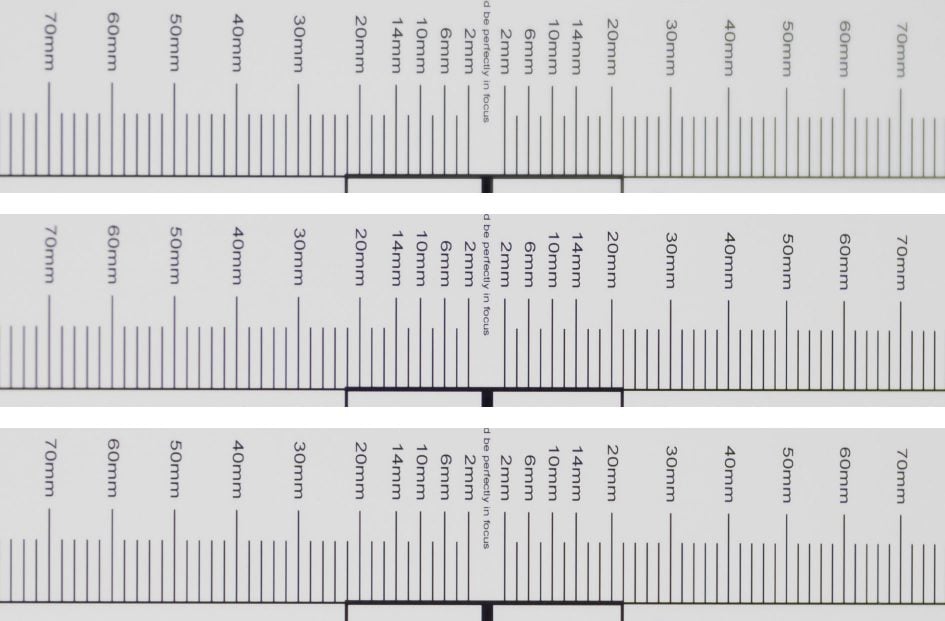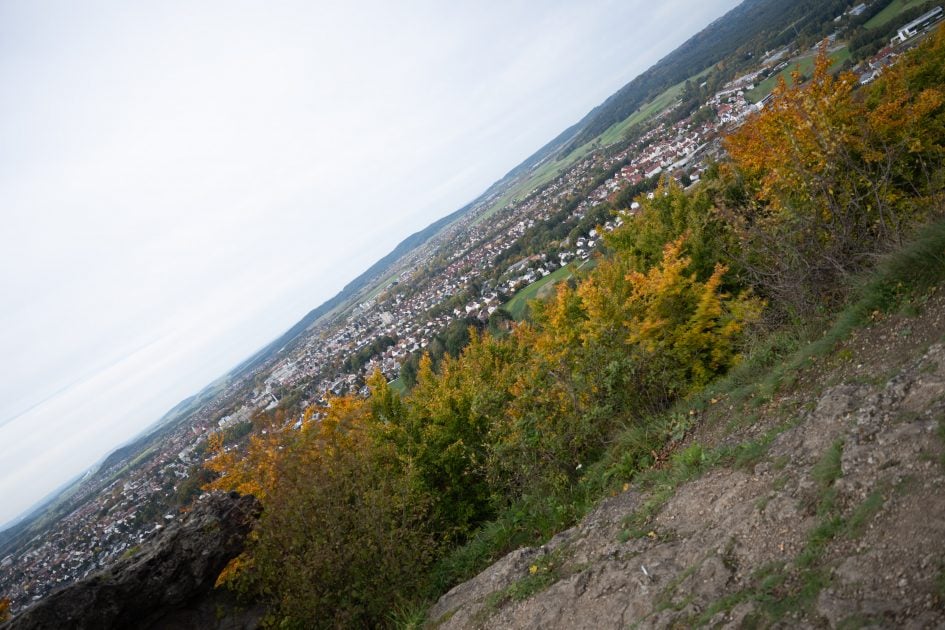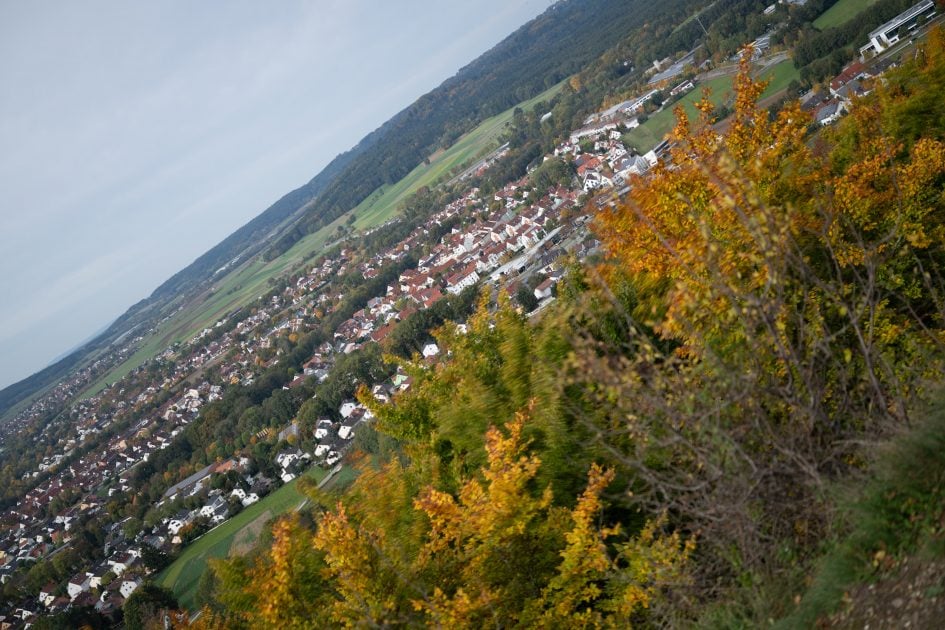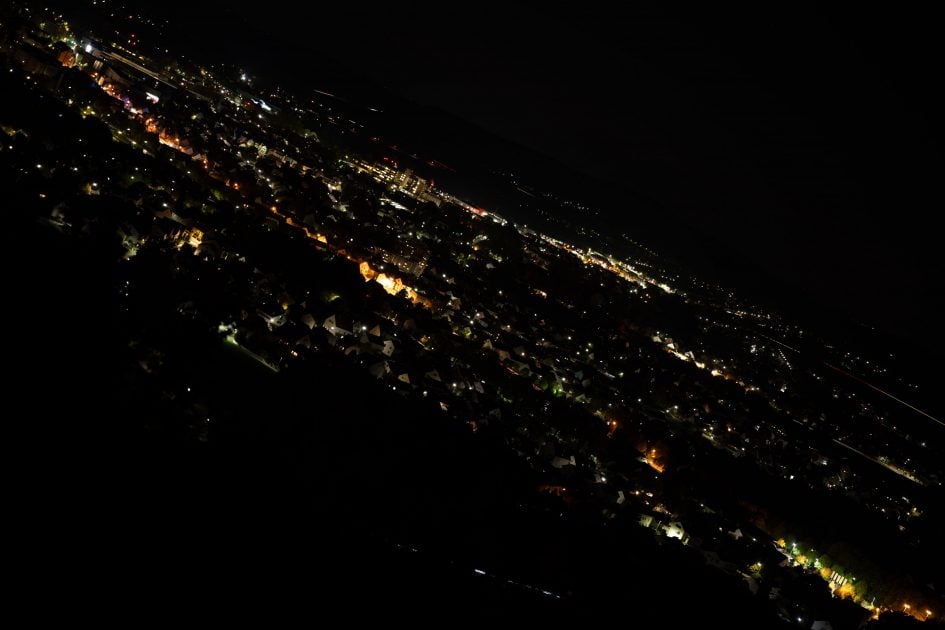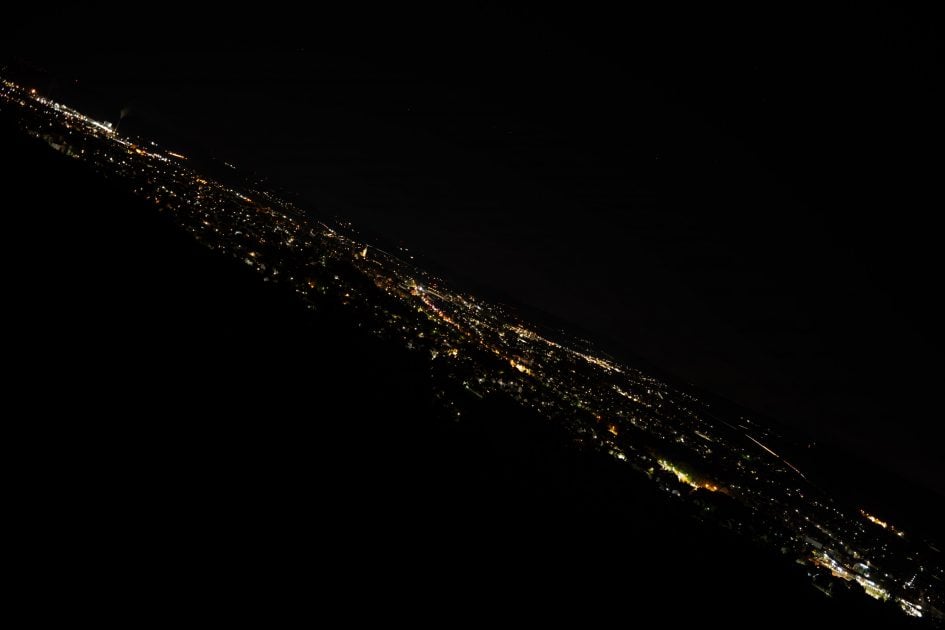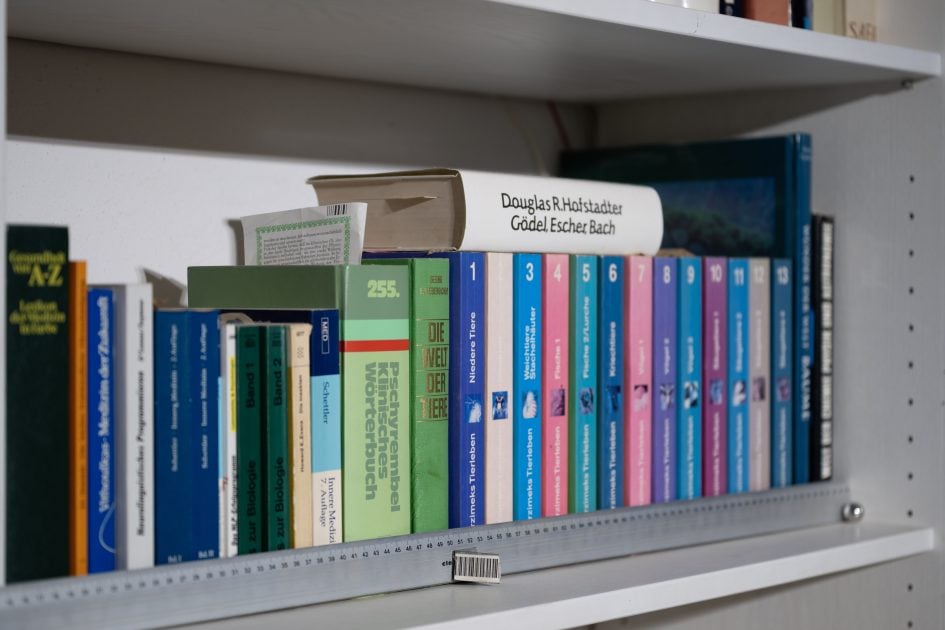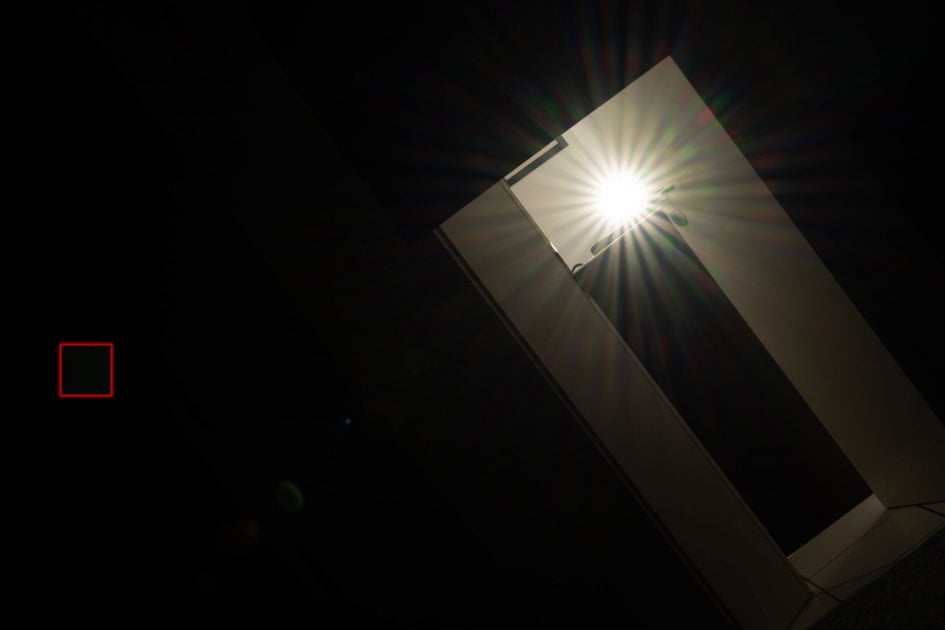Nikon Z 24-70mm f2.8 S II review
-
-
Written by Thomas
Quality
Longitudinal Chromatic Aberration and focus shift
I tested the Nikon Z 24-70mm f2.8 S II at 70mm for longitudinal color aberrations (loCA, a.k.a. “axial color” or “bokeh CA”) and focus shift. The former can show up as magenta coloration in the foreground and greenish hues in the background and are not easily corrected in post-processing. I used pixel shift shooting to reduce any false colors from color moiré:
Nikon Z 24-70mm f2.8 S II loCA at 70mm; 50% crops from 180MP image
Above from top to bottom: f2.8, f4.0, f5.6; left = foreground, right = background; click image for 100% crops
The lens shows practically no loCA but a bit of focus shift between f2.8 and f4.0 where the background becomes sharper much faster than the foreground. The tests also revealed that acuity profits visibly from stopping down to f4.0. See for comparison the same shot at 24mm focal length where there is no focus shift and the lens is already very sharp at f2.8. But a bit of loCA shows:
Nikon Z 24-70mm f2.8 S II loCA at 24mm; 50% crops from 180MP image
Above from top to bottom: f2.8, f4.0, f5.6; left = foreground, right = background; click image for 100% crops
In all of my test-shots with the the Nikon Z 24-70mm f2.8 S II I could not detect any noteworthy purple fringing around high-contrast edges or specular highlights in the focus plane. Spill-over of bright background light is relatively well controlled as is green outlining around background subjects which can only be seen under the harshest conditions:
Above: Nikon Z 24-70mm f2.8 S II at 70mm f2.8, 100% crop; click image for 4k version, here for large original
Sharpness and contrast
Let’s have a look at the theoretical performance of the new Nikon Z 24-70mm f2.8 S II first and compare it to the performance of its predecessor and the Tamron 28-75mm f2.8 Di III G2:

Above: MTF Nikon Z 24-70mm f2.8 S II at 24mm f2.8 (left) and 70mm f2.8 (right)

Above: MTF Nikon Z 24-70mm f2.8 S at 24mm f2.8 (left) and 70mm f2.8 (right)
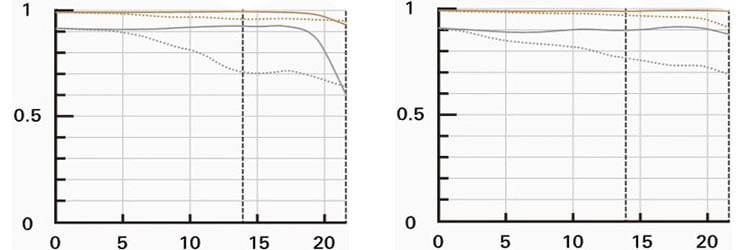
Above: Tamron 28-75mm f2.8 Di III G2 at 28mm f2.8 (left) and 75mm f2.8 (right)
These MTF charts show the computed lens-performance wide open without influence of diffraction at 10 line-pairs/mm (in red/yellow) and 30 lp/mm (in blue/gray). Higher values are better (more contrast) and the closer the dotted and solid lines are together the less astigmatism (= resolution depends on the orientation of the test-pattern) the lens has. The x-axis displays the “image height” which is the distance from the optical axis (=center of the sensor) in mm.
From the charts the new Nikon Z 24-70mm f2.8 S II should have an advantage over its predecessor especially in the fine detail at the long end. The Tamron also looks very good but suffers from stronger astigmatism.
Let’s see how this theoretical performance translates into real life results in the sharpness test based on Siemens-stars shot on a 45MP Nikon Z8 set to 16 image pixel shift shooting. The 16 individual images for each shot were merged in NX Studio 1.9.1 into a 180MP RAW file and further processed in Lightroom 14.5/CRAW 17.5 to Adobe Color profile with the lens profile compensating CA, distortions and vignetting. Noise-reduction was set to 0, sharpening to 50/1/36/10, with no extra tone, color, or saturation adjustment. White-balance was adjusted to a neutral white and I did some exposure compensation to make the brightness of all crops match. So you will not see light fall-off in the corners. I also focused separately for the center, the DX-corner, and FX-corner which eliminates any effect field-curvature might have. If you want to know more about the advantages and perils of pixel shift shooting head over to page 2 of my Tamron 28-75mm f2.8 Nikon Z review.
First up is an overview of the wide-open performance at different focal lengths (presented as 50% crops). You can jump to the detailed results at different apertures and comparisons with other lenses by clicking on the crops of the respective focal length.
Nikon Z 24-70mm f2.8 S II; 50% crops from 180MP image near center, DX-corner, FX-corner
Above: 24mm, f2.8
Above: 35mm, f2.8
Above:50mm, f2.8
Above: 70mm, f2.8
In this overview Nikon’s Z 24-70mm f2.8 S II looks best at 24mm and 35mm with only a mild loss of sharpness towards the FX-corner. At 50mm the DX-corner becomes a bit less well defined and falls behind the FX-corner. Zooming in to 70mm reduces sharpness across the sensor visibly. Field curvature is negligible at 24mm and 70mm and relatively mild at 35mm and 50mm.
Detailed results
The following crops for each focal length show the Nikon Z 24-70mm f2.8 S II from wide open down to f8 compared to the Nikon Z 24-70mm f2.8 S, the Tamron 28-75mm f2.8 Di III G2, and Nikon Z 24-120mm f4 S (shot on a 45MP Nikon Z7 without Pixel shift shooting) at 24mm, 35mm, 50mm, and 70mm. Or you skip the detail and fast-forward to the summary for this chapter.
Performance at 24mm:
Nikon Z 24-70mm f2.8 S II at 24mm compared; 50% crops from 180MP image near center, DX-corner, FX-corner
Above: Nikon Z 24-70mm f2.8 S II at 24mm, f2.8; click image for full resolution 100% crops
Above: Nikon Z 24-70mm f2.8 S at 24mm, f2.8; click image for full resolution 100% crops, also available at f4.0, f5.6, f8.0
Above: Tamron 28-75mm f2.8 Di III G2 at 28mm, f2.8; click image for full resolution 100% crops, also available at f4.0, f5.6, f8.0
Above: Nikon Z 24-70mm f2.8 S II at 24mm, f4.0; click image for full resolution 100% crops

Above: Nikon Z 24-120mm f4 S on a Nikon Z7 (100% crops from 45MP) at 24mm, f4.0; also available at f5.6, f8.0
Above: Nikon Z 24-70mm f2.8 S II at 24mm, f5.6; click image for full resolution 100% crops; also available at f8.0
At 24mm f2.8 the Nikon Z 24-70mm f2.8 S II shows excellent resolution around the center, comparable to its predecessor. The Tamron is just a tiny bit softer. Looking into the DX-corner the Z 24-70mm f2.8 S II is just a bit softer than its predecessor and the Tamron. In the FX-corner both Nikkors perform comparably while the Tamron is a bit softer. At 24mm f4.0 the Nikon Z 24-120mm f4 S enters the competition: Its center is comparable to the Z 24-70mm f2.8 S II, the DX-corner even sharper, only the FX-corner falls behinds Nikon’s new standard zoom.
Performance at 35mm:
Nikon Z 24-70mm f2.8 S II at 35mm compared; 50% crops from 180MP image near center, DX-corner, FX-corner
Above: Nikon Z 24-70mm f2.8 S II at 35mm, f2.8; click image for full resolution 100% crops
Above: Nikon Z 24-70mm f2.8 S at 35mm, f2.8; click image for full resolution 100% crops, also available at f4.0, f5.6, f8.0
Above: Tamron 28-75mm f2.8 Di III G2 at 35mm, f2.8; click image for full resolution 100% crops, also available at f4.0, f5.6, f8.0
Above: Nikon Z 24-70mm f2.8 S II at 35mm, f4.0; click image for full resolution 100% crops

Above: Nikon Z 24-120mm f4 S on a Nikon Z7 (100% crops from 45MP) at 35mm, f4.0; also available at f5.6, f8.0
Above: Nikon Z 24-70mm f2.8 S II at 35mm, f5.6; click image for full resolution 100% crops; also available at f8.0
Comparing the old and new 24-70mm f2.8 Z-Nikkors at 35mm f2.8 shows a tiny advantage for the old lens in the DX image-circle and a clear advantage for the new lens in the FX-corner. The Tamron is almost as sharp around the center as the Z 24-70mm f2.8 S II but falls a bit behind the new Z-Nikkor at the DX- and FX-corner. The Z 24-120mm f4 S shows comparable acuity in the DX image-circle at f4.0 but clearly has the softer FX-corner.
Performance at 50mm:
Nikon Z 24-70mm f2.8 S II at 50mm compared; 50% crops from 180MP image near center, DX-corner, FX-corner
Above: Nikon Z 24-70mm f2.8 S II at 50mm, f2.8; click image for full resolution 100% crops
Above: Nikon Z 24-70mm f2.8 S at 50mm, f2.8; click image for full resolution 100% crops, also available at f4.0, f5.6, f8.0
Above: Tamron 28-75mm f2.8 Di III G2 at 50mm, f2.8; click image for full resolution 100% crops, also available at f4.0, f5.6, f8.0
Above: Nikon Z 24-70mm f2.8 S II at 50mm, f4.0; click image for full resolution 100% crops

Above: Nikon Z 24-120mm f4 S on a Nikon Z7 (100% crops from 45MP) at 50mm, f4.0; also available at f5.6, f8.0
Above: Nikon Z 24-70mm f2.8 S II at 50mm, f5.6; click image for full resolution 100% crops; also available at f8.0
At 50mm f2.8 the Tamron has a small lead over the Z 24-70mm f2.8 S around the center which again is a bit sharper than the new version. At the DX-corner the Z 24-70mm f2.8 S is clearly the sharpest of the trio while the Z 24-70mm f2.8 S II dominates the FX-corner. At f4.0 the Z 24-120mm f4 S again is very close to the Z 24-70mm f2.8 S II in the DX image-circle but has the softer FX-corner.
Performance at 70mm:
Nikon Z 24-70mm f2.8 S II at 70mm compared; 50% crops from 180MP image near center, DX-corner, FX-corner
Above: Nikon Z 24-70mm f2.8 S II at 70mm, f2.8; click image for full resolution 100% crops
Above: Nikon Z 24-70mm f2.8 S at 70mm, f2.8; click image for full resolution 100% crops, also available at f4.0, f5.6, f8.0
Above: Tamron 28-75mm f2.8 Di III G2 at 75mm, f2.8; click image for full resolution 100% crops, also available at f4.0, f5.6, f8.0
Above: Nikon Z 24-70mm f2.8 S II at 70mm, f4.0; click image for full resolution 100% crops

Above: Nikon Z 24-120mm f4 S on a Nikon Z7 (100% crops from 45MP) at 70mm, f4.0; also available at f5.6, f8.0
Above: Nikon Z 24-70mm f2.8 S II at 70mm, f5.6; click image for full resolution 100% crops; also available at f8.0
At 70mm f2.8 the old 24-70mm f2.8 Z-Nikkor is a bit sharper than the new version in the DX image-circle but the Z 24-70mm f2.8 S II has a clear advantage in the FX-corner. The Tamron is also very sharp around the center and produces a nice FX-corner but has the softest DX-corner of the trio. Coming in at f4.0 the Z 24-120mm f4 S surprises by slightly outperforming the Z 24-70mm f2.8 S II across the full frame.
Summary:
All four lenses in this comparison perform on a very high level and are fit for 180MP pixel shift shooting. But they have individual strengths and weakness over their zoom range. The new Nikon Z 24-70mm f2.8 S II has clearly improved FX-corners but within the DX image-circle it’s not better than its predecessor, even falls behind at the DX-corner especially at longer focal lengths. This is a bit disappointing as resolution in the DX-corner certainly is more relevant than in the FX-corner. It’s also a bit different from what the MTF-charts imply at 70mm. Maybe it’s down to sample variations.
Performance at long distances
The Siemens-star test-targets are shot at a distance of 45x focal length (i.e. at around 3.2m for 70mm focal length). But performance of lenses also depends on the shooting distance. Therefore, I shot another series of a city around 1 km away on a Nikon Z8 set to 16 image pixel shift shooting. The 16 individual images for each shot were merged in NX Studio 1.9.0 into a 180MP RAW file and further processed in Lightroom 14.5/CRAW 17.5 to Adobe Color profile with the the lens profile compensating CAs, distortions, and vignetting. Noise-reduction was set to 0, sharpening to 50/1/36/10, with no extra tone, color, or saturation adjustment. I used manual focus at the largest aperture and did not change focus for other apertures. All shots were made from a heavy tripod with image stabilization switched off at ISO 64. As usual I have selected the diagonal that provided the better corner results as the lens was a bit decentered.
The following images show the complete scene wide open plus 50% crops from near center, DX-corner, and FX-corner. All crops in a row are from the same image so there is no compensation for field curvature. You can access the large 180MP original at f2.8 plus 100% crops, but the files are for personal evaluation only and cannot be used in another publication or website without permission. Btw: Any moiré-like artifacts in the foreground resulted from treetops swaying in the wind during pixel shift shooting.
Nikon Z 24-70mm f2.8 S II at 24mm
Above: Nikon Z 24-70mm f2.8 S II at 24mm f2.8; click large image for 4k version, here for large original; crops also available at f4.0, f5.6, f8.0
Nikon Z 24-70mm f2.8 S II at 35mm
Above: Nikon Z 24-70mm f2.8 S II at 35mm f2.8; click image for 4k version, here for large original; crops also available at f4.0, f5.6, f8.0
Nikon Z 24-70mm f2.8 S II at 50mm
Above: Nikon Z 24-70mm f2.8 S II at 50mm f2.8; click image for 4k version, here for large original; crops also available at f4.0, f5.6, f8.0
Nikon Z 24-70mm f2.8 S II at 70mm
Above: Nikon Z 24-70mm f2.8 S II at 70mm f2.8; click image for 4k version, here for large original; crops also available at f4.0, f5.6, f8.0
Summary:
In this long-distance test the Nikon Z 24-70mm f2.8 S II produced the sharpest results across the full frame at 35mm and 50mm focal length. At 24mm the DX- and FX-corner were a bit softer and at 70mm there’s a small loss of acuity towards the FX-corner.
Vignetting and distortions
To make it easier to see light fall-off in the corners of a full-frame sensor I’ve arranged a series of three shots each with the Nikon Z 24-70mm f2.8 S II at 24mm and 70mm focal length and different apertures. All images were developed from RAW to the same brightness in the center and are shown with vignetting correction from the lens profile Off (1st row) or Normal/100% (2nd row):
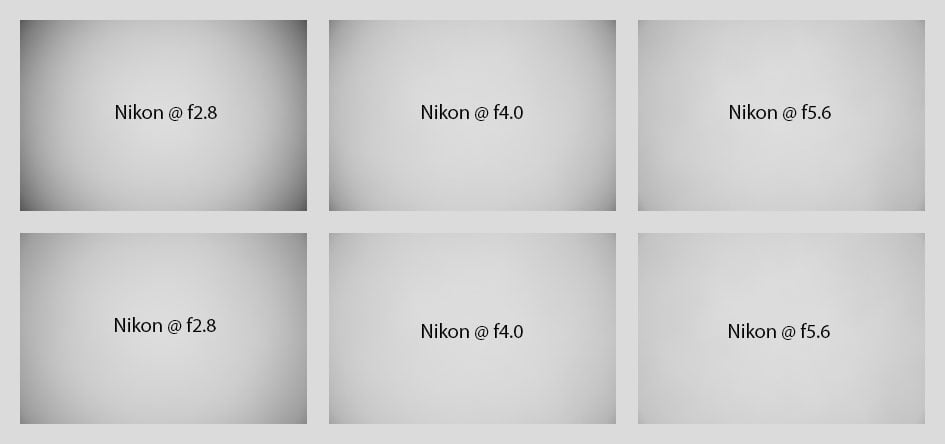
Above: Nikon Z 24-70mm f2.8 S II at 24mm focal length with vignette correction Off (top) or Normal/100% (bottom)

Above: Nikon Z 24-70mm f2.8 S II at 70mm focal length with vignette correction Off (top) or Normal/100% (bottom)
At 24mm focal length vignetting is a very visible -1.6 EV when left uncorrected. At 70mm vignetting wide open is milder. With vignette control set to Normal/100% the extreme corners are lifted by around 0.8 EV at f2.8 – which still leaves a visible vignette at 24mm.
Handling of lens profiles by Adobe’s RAW converter continues to be confusing. Set vignetting and distortion control in camera to On and the Nikon Z 24-70mm f2.8 S II gets its lens profile applied but you can change the strength of the correction in post-processing with sliders between 0 and 200%: Very good! But if you switch vignetting control in camera to Off the slider to control the strength of vignetting in Lightroom or CRAW is disabled. While if you switch distortion control in camera to Off Lightroom/CRAW simply ignore this and the slider is still enabled and set to 100%. NX Studio always applies what was set in camera but you can switch vignetting and distortion control On or Off (unless you have a lens which does not allow auto distortion control to be switched Off). So it’s better to leave the lens profile in camera On which enables all options when processing the image in Lightroom/CRAW.
The following composite images shows the upper half of a large screen TV set displaying grid lines for the full frame and cropped frame. Distortions at 24mm are of a visible barrel/mustachio type, which becomes a pincushion at 70mm. They are perfectly corrected for by the lens profile:

Distortions: Nikon Z 24-70mm f2.8 S II at 24mm, as is (top) / with lens-profile at 100% (bottom)
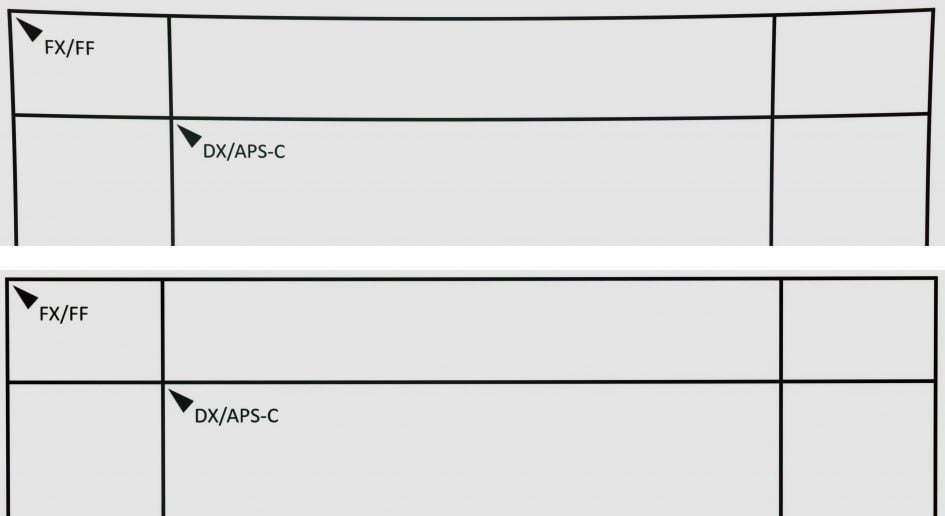
Distortions: Nikon Z 24-70mm f2.8 S II at 70mm, as is (top) / with lens-profile at 100% (bottom)
Rendering of point-light sources at night-shots
Night-shots pose a different challenge for lenses as the contrast is even higher than under bright sun and point-light sources can reveal some weaknesses such as coma, haloing and colour-aberrations that do not show up as prominently in other test-shots. The 100% crops below the main image show the effect of coma in the FX-corner of the Nikon Z 24-70mm f2.8 S II at 70mm and 24mm focal length and different apertures:
Above: Nikon Z 24-70mm f2.8 S II at 70mm, f2.8; click image for 4k version, here for large original

Above: Nikon Z 24-70mm f2.8 S II at 70mm; 100% crops from the FX-corner at f2.8 (left), f4.0 (middle), f5.6 (right)
Above: Nikon Z 24-70mm f2.8 S II at 24mm, f2.8; click image for 4k version, here for large original

Above: Nikon Z 24-70mm f2.8 S II at 24mm; 100% crops from the FX-corner at f2.8 (left), f4.0 (middle), f5.6 (right)
The Nikon Z 24-70mm f2.8 S II is practically free of coma at 70mm. At 24mm focal length there’s a bit of coma.
Bokeh quality
This test is for the rendering of point-light sources in an out-of-focus background. The circle of confusion that is produced by the test is pretty indicative of Bokeh performance (in the background) and light fall-off. Ideally the out-of-focus image of the point-light is evenly lit and perfectly circular, with no “onion-rings”, and without coloration. Lenses normally produce an effect known as “cat’s eye” the further away from the optical axis the point-light is projected. This is due to optical vignetting in the lens barrel when light enters the lens from an angle.
Above: Nikon Z 24-70mm f2.8 S II at 70mm, f2.8; click image for 4k version, here for large original
Above: Nikon Z 24-70mm f2.8 S II at 70mm f2.8; click image for 100% crops
Above: Nikon Z 24-70mm f2.8 S II at 70mm f4.0; click image for 100% crops
Above: Nikon Z 24-70mm f2.8 S II at 70mm f5.6; click image for 100% crops
The Nikon Z 24-70mm f2.8 S II shows a normal amount of compression of the circle in the DX- and FX-corner wide open. There is some outlining albeit free of coloration from loCA. The inside of the Bokeh balls at f2.8 shows a pupil-like effect in the center but is otherwise smoothly textured with only weak onion rings.
Let’s see how this analysis of out-of-focus point-light sources translates into Bokeh-performance shooting a book-shelf. Crops are from the foreground, middle-ground, and background resized to make them comparable across all my reviews:
Above: Nikon Z 24-70mm f2.8 S II at 70mm f2.8; click image for 4k version, here for large original
Above: Nikon Z 24-70mm f2.8 S II at 70mm f2.8; click image for 100% crops, here for large original
Above: Nikon Z 24-70mm f2.8 S at 70mm, f2.8; click image for 100% crops, here for large original
Above: Tamron 28-75mm f2.8 Di III G2 at 75mm, f2.8; click image for 100% crops, here for large original
The Nikon Z 24-70mm f2.8 S II produces a nice, smooth Bokeh in the transition zone and the background without any coloration. Only the (less important) foreground looks a bit harsher. Both the Nikon Z 24-70mm f2.8 S and Tamron 28-75mm f2.8 Di III G2 look more nervous in the background.
Looking at the ruler (below, now at 100%) shows that the Z 24-70mm f2.8 S II is practically free of double-contours in the middle-ground but produces some in the foreground:

Above: Nikon Z 24-70mm f2.8 S II at 70mm f2.8, 100% crop from middle-ground

Above: Nikon Z 24-70mm f2.8 S II at 70mm f2.8, 100% crop from foreground
Close-up performance
The Nikon Z 24-70mm f2.8 S II achieves a maximum magnification of 1:4.5 at 24mm focal length with an area of sharp focus of 108 x 162mm. The following set of crops was shot at 1:4.7 from 1mm, 9mm, and 19mm off the center of the sensor respectively. I focused separately for each crop to avoid the influence of field curvature.
Nikon Z 24-70mm f2.8 S II at 24mm, 1:4.7 magnification; 100% crops

Above: Nikon Z 24-70mm f2.8 S II at 24mm f2.8

Above: Nikon Z 24-70mm f2.8 S II at 24mm f5.6

Above: Nikon Z 24-70mm f2.8 S II at 24mm f11
Wide open the lens produces a pretty sharp center (up to 6mm image height). But to get good sharpness towards the DX-corners stop down to f5.6 – or f11 if you want usable FX-corners.
At 70mm focal length the lens achieves a maximum magnification of 1:2.8 with an area of sharp focus of 67 x 101mm. The following set of crops was shot at 1:3.0 from 0mm, 14mm, and 20mm off the center of the sensor respectively. I did not focus separately for each crop because field curvature of the lens at 70mm is pretty low towards the FX-corner.
Nikon Z 24-70mm f2.8 S II at 70mm, 1:3.0 magnification; 100% crops

Above: Nikon Z 24-70mm f2.8 S II at 70mm f2.8

Above: Nikon Z 24-70mm f2.8 S II at 70mm f5.6

Above: Nikon Z 24-70mm f2.8 S II at 70mm f11
Stopping down to f5.6 results in usable (but not good) resolution across the full frame – f11 is a better choice to produce sharp close-ups.
Flare, ghosting, and sun-stars
Catching a strong light-source shining directly into the lens is always a risky business: it could produce strange colorful ghost-images or reduce contrast considerably through flare and glare. The appearance of flare and ghosting depends on factors like the aperture and the angle of the light hitting the lens. So, to judge the proclivity of the Nikon Z 24-70mm f2.8 S II for these artifacts I went through a series of well calculated shots against a strong light source to provoke glare and ghosting. The lens hood was mounted in all shots. Following are two examples with ghosts. But they are so weak that you need to open the +3 EV version of the images to see them. The little red square inset in the upper left shows the respective area with an exposure compensation of +3 EV to make it easier to see which levels of black the lens renders at that point:
Above: Flare and ghosting. Strong light hitting the Nikon Z 24-70mm f2.8 S II at 24mm, f11; click image for 4k version or here for +3 EV exposure compensation
Above: Flare and ghosting. Strong light hitting the Nikon Z 24-70mm f2.8 S II at 70mm, f11; click image for 4k version or here for +3 EV exposure compensation
Throughout its zoom range the Nikon Z 24-70mm f2.8 S II produces very little ghosting artifacts, flares, and veiling glare: The blacks stay deep black so the lens can confidently be used in challenging contra-light situations. This is clearly better than the results from the Z 24-70mm f2.8 or the Tamron 28-75mm f2.8 Di III G2.
Sunstars are not the forte of Nikon’s new standard zoom lens due to the well rounded aperture blades. They are OK at f11 (see above) but almost non-existent at f8.0 or faster apertures:

Above: Sunstars from the Nikon Z 24-70mm f2.8 S II at 24mm f8.0 (left), 70mm f8.0 (right); 100% crops
Next check out my sample images!
Check prices on the Nikon Z 24-70mm f2.8 S II at B&H, Adorama, WEX UK or Calumet.de. Buy used gear from MPB. Sell your used gear to MPB. Alternatively get yourself a copy of my In Camera book, an official Cameralabs T-shirt or mug, or treat me to a coffee! Thanks!
